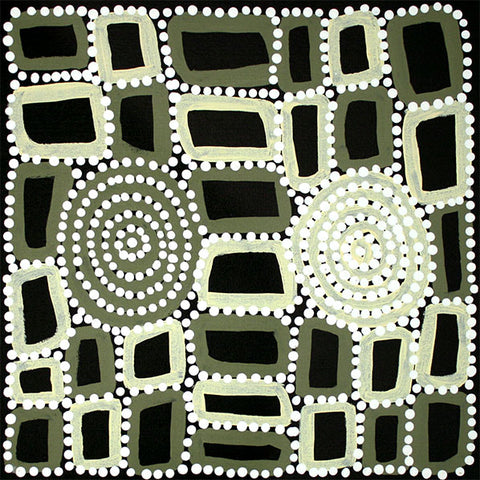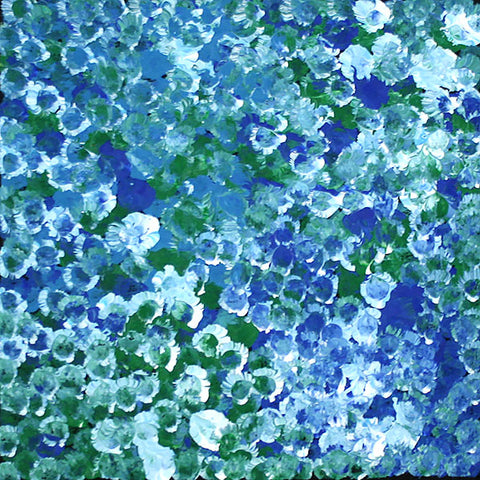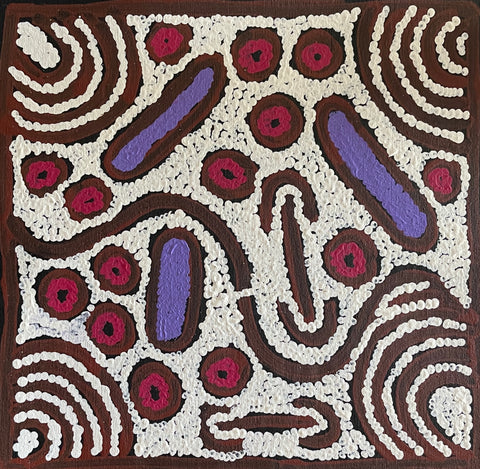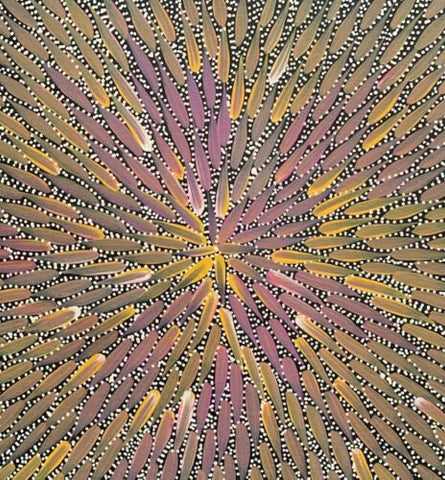The witch doctor, 2013 | 30h x 30w | RK939
Not stretched or framed | Acrylic on linen
Linda Syddick Napaltjarri (c.1937-2021) was a Pintupi woman from the Gibson Desert in Western Australia. Her Aboriginal name is Tjunkiya Wukula Napaltjarri, she was the daughter of Wanala Nangala and Rintja Tjungurrayi. Linda lived a traditional nomadic life with her people until the age of about eight, at this time her family walked out of the desert and decided to settle at the Lutheran Mission at Haasts Bluff, in the Northern Territory.
Linda's paintings were inspired by both her traditional nomadic life in the desert, and the Dreaming of her father and stepfather. Linda's father was killed by a revenge spearing party in accordance with Customary Law when Linda was about eighteen months old; her stepfather, artist Lankata Shorty Tjungurrayi, subsequently brought her up. Before Lungkata died in 1985, he instructed Linda to carry on his work and paint his Dreaming. And so, in 1986, her two Uncles Uta Uta Tjangala and Nosepeg Tjupurrula taught Linda the art of painting. Her mother later married artist Shorty Lungkarta Tjungarrayi. His work was a significant influence on Linda's painting. Linda married several times, and still uses the family name of her second husband Musty Syddick (Cedick).
Linda collected the stories from her life into a series of images that represent the major turning points in her journey. She drew on metaphysical stories she later learned in the mission settlements and fused them with her memories of the desert and Tingari Creation events.
Linda’s most common painting story is ‘The Witchdoctor and the Windmill”. She painted all the elements of this story in different ways, showing the whirring blades of the windmill, the Old Nangkari man and her stepfather, the spears and other items that they carried with them in from the desert. Sometimes the family group is shown camped nearby, by using traditional symbols. All around the central motifs are the Sandhills of the desert, showing where the group of people have travelled from. In 2006, Linda was the winner of the NAATSIA Award for a representation of this story.
Her work is revered by galleries, academics, and collectors worldwide.
The story of ‘The Witchdoctor and the Windmill’
This is a story that Linda loved to paint, it documents the first contact some of her family group had with European settlement, when, in 1945, they walked out of their Pintupi homelands near Lake MacKay in the Gibson Desert, heading east for Haasts Bluff Mission. Linda was eight years old at the time and the 350 kilometers they travelled was largely over rugged sandhill terrain.
Shorty was the only one to have had contact with the “whitefella world”. They camped by the windmill and Shorty told his family not to be afraid and explained that the windmill was for getting water.
As they were walking along, one of their group, the Nangkari, a highly respected medicine man and healer, and his two wives, had lagged behind a little as they approached Mt Liebig, The Nangkari, an elderly man by then, lay down and had a sleep, not seeing the windmill before he closed his eyes. His wives, however, saw it whirring around, and not knowing what it was, took off into the bush screaming.
Upon waking, the Nangkari, who had had no experience of white people, also saw the windmill with its vanes flailing in the wind and making a mighty roaring noise. He took it to be the evil spirit, Tutju “devil devil”. To protect his people, he started throwing spears at it, but they just bounced back. He then used his magic powers and produced stones from his body to throw at it, but they, too, failed to stop it.
Finally, noticing that The Nangkari and his wives weren’t among the group, Linda’s stepfather (Shorty), walked back to find them. Shorty managed to convince the Nangkari that it wasn’t the Devil but that it was a device that provided good water. The Nangkari, eventually pacified, drank some of the water, and satisfied that it was good, was happy, and the family group then travelled on.
Please Note: This Artist passed away in 2021 and out of respect for Aboriginal culture, we have removed the photograph of this Artist holding this artwork from our website.




